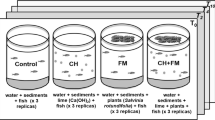Abstract
The paper presents the results of experiments with mesomodeling of water pollution in a lowland freshwater body by a mixture of salts of heavy metals (Cd, Zn, Cu). The response of phytoplankton (in terms of primary production characteristics) to the presence of heavy metals in water and to the introduction of a sorbent based on mechanochemically oxidized humic acids has been studied. The removal of heavy metals by phytoplankton on the 16th day of the experiment has reduced the concentration of Cd(II) to 62, Zn(II) to 58- and Cu(II) to 46% of their initial levels. The application of a sorbent under the same conditions has led to a decrease in the concentration of Cd(II) to 21, Zn(II) to 27, and Cu(II) to 10% of the initial level. The examined sorbent does not cause blooming in the water body, thus it differs from the sorbents that contain humic acids with a native structure of molecules.




Similar content being viewed by others
REFERENCES
Bruevich, S.V., Problemy khimii morya (Problems in Marine Chemistry), Moscow: Nauka, 1978.
Bryanskaya, A.V., Dvurechenskaya, S.Ya., Puzanov, A.V., and Pel’tek, S.E., Studying the toxicity of wastewater entering the Novosibirsk Reservoir, Voda: Khim. Ekol., 2013, vol. 63, no. 9, pp. 19–23.
Vasil’ev, O.F., Savkin, V.M., Dvurechenskaya, S.Ya., et al., Environmental condition of the Novosibirsk Reservoir, Sib. Ekol. Zh., 2000, no. 2, pp. 149–163.
Vasil’ev, O.F., Savkin, V.M., Dvurechenskaya, S.Ya., and Popov, P.A., Water-management and environmental problems of the Novosibirskoe Reservoir, Water Resour., 1997, vol. 24, no. 5, pp. 538–545.
Dvurechenskaya, S.Ya. and Bulycheva, T.M., Hydrochemical regime and water quality in the Novosibirsk Reservoir, in Mnogoletnyaya dinamika vodno-ekologicheskogo rezhima Novosibirskogo vodokhranilishcha (Long-Term Dynamics of the Water–Ecological Regime of the Novosibirsk Reservoir), Novosibirsk: Sib. Otd. RAN, 2014, pp. 54–89.
Kulikova, N.A., Binding capacity and detoxication properties of humic acids with respect to atrazine, Cand. Sci. (Biol.) Dissertation, Moscow: Moscow State Univ., 1999.
Mirkin, B.M. and Naumova, L.G., Osnovy obshchei ekologii (Fundamentals of General Eclogy), Moscow: Universitet. kn, 2005.
Naumenko, Yu.V., Phytoplankton of the Ob River, Extended Abstract of Doctoral (Biol.) Dissertation, Novosibirsk, 1996.
Ogryzkova, O.S., Eirikh, A.N., Serykh, T.G., et al., Seasonal variations of manganese concentration in Novosibirsk Reservoir water, Izv. Altai Gos. Univ., 2014, vol. 83, no. 2, pp. 176–180.
Romanov, R.E. and Kim, G.V., The composition and structure of algotsenoses, in Mnogoletnyaya dinamika vodno-ekologicheskogo rezhima Novosibirskogo vodokhranilishcha (Long-Term Dynamics of the Water-Ecological Regime of the Novosibirsk Reservoir), Novosibirsk: Izd. Sib. Otd. RAN, 2014, pp. 90–131.
Savkin, V.M., Siberian reservoirs, water-ecological and water-management effects of their construction, Sib. Ekol. Zh., 2000, no. 2, pp. 109–121.
Savkin, V.M. and Dvurechenskaya, S.Ya., Influence of long-standing changes of hydrological and hydrochemical regime of Novosibirsk Reservoir on ecological conditions of water use, Contemp. Probl. Ecol., 2010, no. 4, pp. 481–486.
Smolyakov, B.S., Belevantsev, V.I., Zhigula, M.V., et al., Mesocosm-based estimation of the consequences of complex contamination of a freshwater body by metal salts, Water Resour., 2004, vol. 31, no. 3, pp. 365–374.
Smolyakov, B.S., Bortnikova, S.B., Zhigula, M.V., Fedotova, A.A., Ermolaeva, N.I., and Artamonova, S.Yu., Mesosimulation of the complex pollution of a freshwater body by metal salts (Pb, Cu, Zn, Cd) at variations of their chemical forms in solution, Vodn. Resur., 2004, vol. 31, no. 3, pp. 365–374.
Smolyakov, B.S. and Plekhanov, D.F., Assessing the primary production in a freshwater body by the daily dynamics of water pH, Zh. Ekol. Chem., 1994, vol. 3, nos. 3–4, pp. 201–205.
Tikhonov, V.V., Orlov, D.S., Lisovitskaya, O.V., et al., Sorption of humic acids by bacteria, Mikrobiology, 2013, vol. 82, no. 6, pp. 707–712.
Urazova, T.S., Bychkov, A.L., and Lomovskii, O.I., Mechanochemical modification of the structure of brown coal humic acids for preparing a sorbent for heavy metals, Russ. J. Appl. Chem., 2014, vol. 87, no. 5, pp. 651–655.
Belevantsev, V.I., Ryzhikh, A.P., and Smolyakov, B.S., Diurnal and vertical variability of pH (O2), and Eh in the Novosibirsk Water Reservoir, Russian Geol. Geoph., 2008, no. 49, pp. 673–681.
Fu, F. and Wang, Q., Removal of heavy metal ions from wastewaters: a review, J. Environ. Manage., 2011, vol. 92, no. 3, pp. 407–418.
Ghabbour, E.A., Shaker, M., El-Toukhy, A., Abid, I.M., and Davies, G., Thermodynamics of metal cation binding by a solid soil-derived humic acid: binding of Fe(III), Pb(II), and Cu(II), Chemosphere, 63, 2006, pp. 477–483.
Khan, F.A. and Ansari, A.A., Eutrophication: an ecological vision, Bot. Rev., 2005, vol. 71, no. 4, pp. 449–482.
Mohan, D. and Pittman, Jr., C.U., Arsenic removal from water/wastewater using adsorbents—a critical review, J. Haz. Mater., 2007, vol. 142, nos. 1–2, pp. 1–53.
Petersen, R.C., The contradictory biological behavior of humic substances in the aquatic environment, Humic Substances in the Aquatic and Terrestrial Environment, Berlin Heidelberg: Springer-Verlag, 1991, pp. 369–389.
Smolyakov, B.S., Ryzhikh, A.P., and Romanov, R.E., The fate of Cu, Zn, and Cd in the initial stage of water system contamination: the effect of phytoplankton activity, J. Haz. Mat., 2010, vol. 184, pp. 819–825.
Takenaga, H. and Aso, S., Studies on the physiological effect of humic acid, Part 9, Stability constants of cation-nitrogenic acid chelates, Soil Sci. Plant Nutr., 1976, vol. 22, no. 1, pp. 103–104.
Tipping, E., Cation Binding by Humic Substances, UK (Windermere): Cambridge Univ. Press, 2002.
Tulonen, T., Salonen, K., and Arvola, L., Effects of different molecular weight fractions of dissolved organic matter on the growth of bacteria, algae and protozoa from a highly humic lake, Hydrobiologia, 1992, no. 229, pp. 239–252.
ACKNOWLEDGMENTS
This study was supported by the Russian Foundation for Basic Research, project no. 17-05-00623.
Author information
Authors and Affiliations
Corresponding author
Additional information
Translated by G. Krichevets
Rights and permissions
About this article
Cite this article
Skripkina, T.S., Bychkov, A.L., Smolyakov, B.S. et al. Changes in Phytoplankton Production after the Introduction of Heavy Metals into Ecosystem with Subsequent Cleaning by Humic Sorbent. Water Resour 46, 242–248 (2019). https://doi.org/10.1134/S0097807819020167
Received:
Accepted:
Published:
Issue Date:
DOI: https://doi.org/10.1134/S0097807819020167




